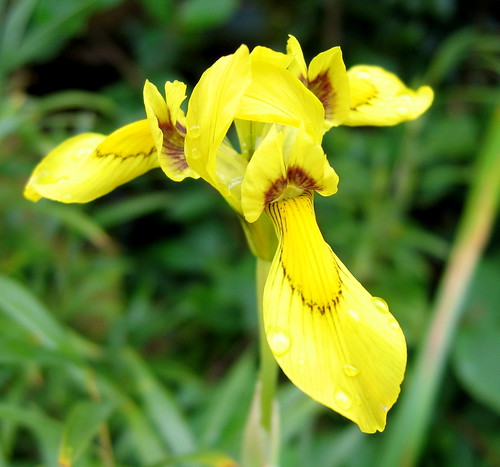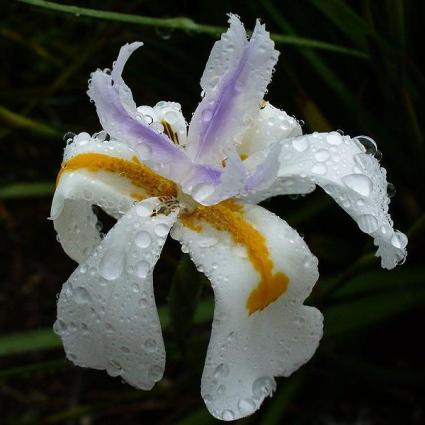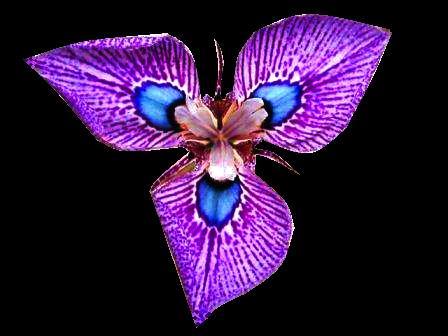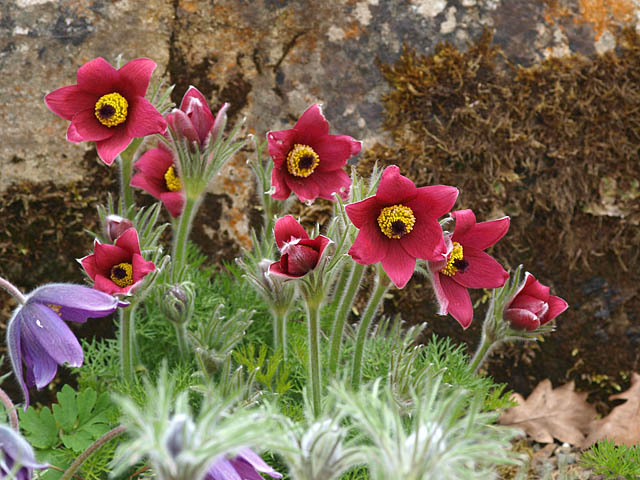From left: Wachendorfia thrysiflora, Hedychium densiflorum or Ginger Lily, Libertia grandiflora and Dietes grandiflora
Now, cleverclogs, I know Libertia is from New Zealand and the Ginger Lily is from sub-tropical parts of the foothills of the Himalayas in India, but one day at a time. With the possible exception of the Libertia (bit dull), these are lovely plants and will help to determine just what I can get away with in terms of hardiness as the Dietes is right on the border of 0C, which, if I live in Altnaharra (-21.1C), I'd probably have lost a few leaves by now.
Handily, they all like a very free-draining humus soil so I took them out and potted them up in the remains of a rotting bark/perlite/MiracleGro all purpose and slow release food granules I'd prepared for something else (oh yes, Rhododendrons) but giving what I hope is the right mix of humus (enter pitta-based joke here yourself) and drainage. They're in clay pots because a) they're slightly less likely to fall over and b) if I overwater a clay pot dries out a lot faster than plastic; a curse and a blessing for those who don't like climbing in and out of windows with hoses and watering cans full of specialist bulb food which has extra potash for bulking up bulbs.
Wachendorfia thrysiflora grows along the edges of streams so needs a lot of water but doesn't want it to stay in the pot very long. That's taking the already oxymoronic notion of a moist, free draining soil and just making it even sillier!
Call me on old pedant if you want but i become annoyed when people lump Dietes in with Irises in their catalogues etc. Yes, grandiflora is in the Iridaceae and does a bloody good impression and, without being able to read books, I'd be fooled too. But it is of course a distinct genus with many beautiful species, one or two of which I showed you yesterday. Another genus which suffers this confusion is the Moraea, largely because of huttoni, which I'm attempting from about half a dozen seeds (this maximum quantity of about 12 seems to be a foreign thing and I suppose, if you're just after one specimen and a back-up, it makes sense by keeping everything small: pot, compost etc. I presume if you buy a packet of Foxgloves in America you get 100+ seeds?)
Spot the difference 


Here we have, from top, Moraea huttonii, Iris wilsonii and Iris forestii, although there is a constant battle among the taxonomists over the two Irises. It's not one I wish to get involved in but they do look very similar. I. wilsonii is the yellow end of a spectrum for the species that ends with bluey purple. In other words, it's very variable. I am led to understand that I. forestii comes in any colour as long as it's yellow, although there are slight variations in shade and probably a white form, most species do. But my point is, they all look very similar to all but the most keen follower of Irises. And my other point is, it had opened up a whole new, largely South African, genus for me to plunder, the Moraea, which followers will have seen me get excited about recently.
Can I just show you one?
Amazing, eh? If I can get things like this surviving on the roof I will be a very happy plantboy!
And so to today. Apart from dealing with the delivery, I decided to sow some seeds, not expecting any germination action for a month or three but the seeds of some, such as the three species of Pulsatilla, need to spend the winter outside so P. vulgaris (red form), P. sulphurea and P. dahurica were sown and, as the clearly erudite instructions said, barely covered. I used perlite for this because I don't trust myself to spread a thin layer of compost so I hope it doesn't just blow away. Actually, Tesco freezer bags are ideal for zipping up the biodegradable pots I'm using (they're about the size of a CD (5in) but shallower than you might expect) so I'll do that to make sure none of my FIVE seeds of P. sulphurea blows away (or if interfered with whatever is causing havoc out there every night. It dug up most of a tray of Meconopsis Grandis last night and is really keen on Lilies (I receently spent £80 on the most amazing Lilies such as fargesii, below)

But back to the Pulsatillas. If they germinate in time they should flower in 2011.
From top: sulphurea, vulgaris, red form, dahurica
Also today I sowed Lilium Pumilum, even though I have small bulbs of it, L. ex Royal River (no idea what to expect from this as I don't know the parentage, and Anthyllis vulneraria var. coccinea
Quite what to expect from the Ex-Royal River hybrid I have no idea. The seed company are specialists so they know what they're doing. Is the idea to get a seedling that look's like the parent (boring) or are we hoping some genes from way back make a reappearance (interesting, although I don't like those stumpy lillies with the upward facing blooms like that).
Anyway, that's all for now, short one today, will update on, well, everything. Good luck with the weather, whatever it brings.
The Plantboy |














No comments:
Post a Comment